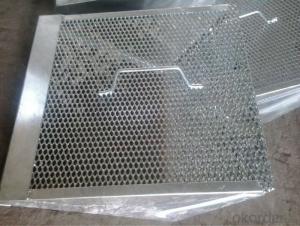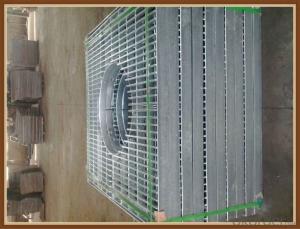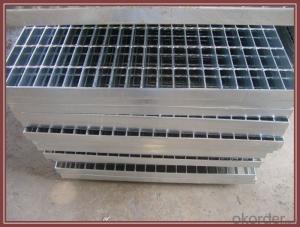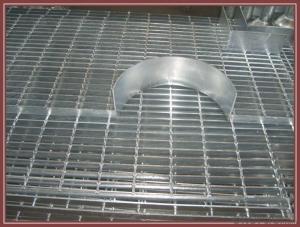Aluminum Grating For Suspended Ceiling Galvanized Or Painted
- Loading Port:
- Shanghai
- Payment Terms:
- TT OR LC
- Min Order Qty:
- 5000 pc
- Supply Capability:
- 6000000 pc/month
OKorder Service Pledge
OKorder Financial Service
You Might Also Like
1.Description of Drainage trench cover:
Drainage trench cover is widely used in the urban road, the square, the botanical garden, the wharf, the airport, the parking lot, the road, each kind of industry, the civil project, etc.
2.Main features of Drainage trench cover:
I--Carrying 20 tons of weight
II—Carrying 14 tons of weight
III---carrying 6 tons of weight
IV---carrying 2 tons of weight
V---Carrying pedestrian weight
3.Glass Wool Blanket Images:

4. Drainage Trench Cover Technical Parameters:
These drain cover plate applies to the road cross-sectional and longitudinal drain. The drains width ranging from 200mm to 550mm.
A means the steel grating length
H means the steel grating height
A means the frame length
H means the frame height
5.FAQ
We have organized several common questions for our clients,may help you sincerely:
①How about your company?
A world class manufacturer & supplier of Drainage trench cover is
one of the large scale professional investment casting production bases in China,consisting of both casting foundry forging and machining factory. Annually more than 8000 tons Precision casting and forging parts are exported to markets in Europe,America and Japan. OEM casting and forging service available according to customer’s requirement.
②How to guarantee the quality of the products?
We have established the international advanced quality management system every link from raw material to final product we have strict quality test; We resolutely put an end to unqualified products flowing into the market. At the same time, we will provide necessary follow-up service assurance.
- Q:Iron is extracted from iron oxide by displacement with carbon.But aluminum is not extracted from aluminium oxide using displacement by carbon. Suggest a reason for this.
- Well, de facto because the heat of formation of aluminum oxide is so much greater than the heat of formation of iron oxide. If you're looking for something more mechanistic, find Al and Fe in the periodic table. Al and Fe are in different rows, and Fe is larger than Al, so although Al+3 and Fe+3 have the same charge, oxygen bonds less strongly to Fe+3 than to Al+3 because it's further away from the nucleus of Fe. Al+3 has no outer shell electrons at all; 3s, 3p, and 3d subshells are all empty. It's effectively a charged sphere with nothing to interfere with bonding. Fe+3 (as in hematite, Fe2O3) is larger, has filled 3s and 3p subshells, and a half-filled 3d subshell. That 3d electron density projects pretty far out into space, holding oxygen at arms length. Aluminum has no electron density in 3d orbitals, so oxygen can tuck in nice and tight and get a good grip. Any of these hit the mark? I don't know what background you're bringing to this question.
- Q:Can aluminum sheets be used for heat sinks?
- Yes, aluminum sheets can be used for heat sinks. Aluminum has excellent thermal conductivity properties, making it an ideal material for transferring heat away from electronic components. Aluminum sheets can be formed into various shapes and sizes to maximize heat dissipation. They are commonly used in applications such as computer processors, LED lights, and power electronics, where efficient heat dissipation is crucial for maintaining optimal performance and preventing overheating. Additionally, aluminum sheets are lightweight and cost-effective, making them a popular choice for heat sink applications.
- Q:how to avoid oxidation of aluminum sheet after wire drawing?
- leave it alone after wire drawing!aluminum sheet will formulate a layer of dense oxide film. So you don't need to worry about it! Don't often polish the aluminum wire, or they will be more and more slimsy, the oxide film is used for avoiding reoxidation.
- Q:Can aluminum sheet be used for aerospace applications?
- Certainly, aluminum sheet finds application in the aerospace industry. Owing to its advantageous characteristics, including being lightweight, highly robust, and resistant to corrosion, aluminum is extensively employed in this sector. It is frequently utilized in the fabrication of aircraft fuselages, wings, and structural elements. Aluminum sheets are commonly employed in the production of aircraft panels, where their exceptional strength-to-weight ratio facilitates enhanced fuel efficiency and greater payload capacity. Furthermore, aluminum sheets offer versatility and suitability for a wide range of aerospace applications due to their ease of forming, machining, and welding.
- Q:What is the typical torsional strength of aluminum sheets?
- The typical torsional strength of aluminum sheets can vary depending on various factors such as the alloy composition, thickness, and manufacturing process. However, in general, aluminum sheets have a good torsional strength compared to other materials. Aluminum alloys commonly used in sheet form, such as 6061-T6 and 5052-H32, have torsional strengths ranging from approximately 22,000 to 40,000 pounds per square inch (psi). These values represent the maximum amount of torque that can be applied to the aluminum sheet before it permanently deforms or fractures. It is important to note that torsional strength is just one aspect of the overall mechanical properties of aluminum sheets. Other factors like tensile strength, yield strength, and elongation also play significant roles in determining the suitability of aluminum sheets for specific applications. Therefore, when selecting aluminum sheets for a particular torsional application, it is essential to consider the specific requirements and consult with material suppliers or engineers to ensure the chosen aluminum sheet meets the desired torsional strength requirements.
- Q:Can the aluminum sheets be used for architectural cladding?
- Indeed, architectural cladding can make use of aluminum sheets. Owing to its lightweight properties, durability, and versatility, aluminum remains a favored selection for cladding purposes. Its pliability and ability to assume diverse forms make it ideal for a broad spectrum of architectural designs. Furthermore, aluminum boasts corrosion resistance, ensuring its longevity as a cladding option. Moreover, the possibility of coating aluminum in various finishes enables customization to align with the desired aesthetic of the structure. All things considered, aluminum sheets emerge as a dependable and pragmatic choice for architectural cladding.
- Q:What are the dimensions of standard aluminum sheets?
- Standard aluminum sheets typically have dimensions of 4 feet by 8 feet. However, it's important to note that aluminum sheets come in various thicknesses, ranging from thin gauge sheets to thicker plates. The thickness of standard aluminum sheets can vary from 0.025 inches to 0.25 inches or more. Additionally, aluminum sheets can be cut and customized to different sizes and shapes based on specific project requirements.
- Q:Some say you should use the 'dull' side of aluminum foil when cooking etc. There's something potentially bad about the shiny side.True or not?
- that is a myth, the only difference might be how much heat is reflected. Go to Discovery or Metacafe and type How it is made, aluminum foil and you will see why it is a myth.
- Q:Can aluminum sheets be used in the aerospace industry?
- Yes, aluminum sheets can be used in the aerospace industry. Aluminum is a lightweight material with excellent strength-to-weight ratio, making it a popular choice for various aerospace applications. It is commonly used in the construction of aircraft structures, such as fuselages, wings, and panels. The use of aluminum sheets in the aerospace industry offers several benefits, including reduced fuel consumption due to the weight savings, improved maneuverability, and increased payload capacity. Additionally, aluminum exhibits good corrosion resistance, which is crucial for aircraft exposed to harsh environmental conditions. Overall, aluminum sheets are widely utilized in the aerospace industry for their favorable properties and performance.
1. Manufacturer Overview |
|
|---|---|
| Location | |
| Year Established | |
| Annual Output Value | |
| Main Markets | |
| Company Certifications | |
2. Manufacturer Certificates |
|
|---|---|
| a) Certification Name | |
| Range | |
| Reference | |
| Validity Period | |
3. Manufacturer Capability |
|
|---|---|
| a)Trade Capacity | |
| Nearest Port | |
| Export Percentage | |
| No.of Employees in Trade Department | |
| Language Spoken: | |
| b)Factory Information | |
| Factory Size: | |
| No. of Production Lines | |
| Contract Manufacturing | |
| Product Price Range | |
Send your message to us
Aluminum Grating For Suspended Ceiling Galvanized Or Painted
- Loading Port:
- Shanghai
- Payment Terms:
- TT OR LC
- Min Order Qty:
- 5000 pc
- Supply Capability:
- 6000000 pc/month
OKorder Service Pledge
OKorder Financial Service
Similar products
New products
Hot products
Related keywords






























